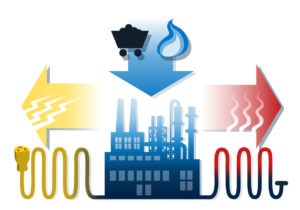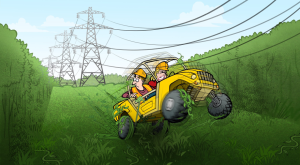Facts, Figures, and Findings from EPRI Research, Reports, and Other Sources

Study: Combined Heat and Power Has Potential to More Than Double Its U.S. Capacity
Pop quiz: During and after Hurricane Sandy, which generation technology stepped up to help hospitals, schools, residential buildings, and a water treatment plant continue operations? Answer: Combined heat and power (CHP), a type of distributed generation that combusts various fuels to produce heat and electricity for local consumption, saving energy costs. In traditional fossil-powered electricity generation, much of the heat is wasted. EPRI's market assessment of CHP found that the United States has 4,400 such facilities, with 83 gigawatts or 8% of total power generation capacity ...
Read More
Pop quiz: During and after Hurricane Sandy, which generation technology stepped up to help hospitals, schools, residential buildings, and a water treatment plant continue operations? Answer: Combined heat and power (CHP), a type of distributed generation that combusts various fuels to produce heat and electricity for local consumption, saving energy costs. In traditional fossil-powered electricity generation, much of the heat is wasted. EPRI's market assessment of CHP found that the United States has 4,400 such facilities, with 83 gigawatts or 8% of total power generation capacity ...
Read More

Low-Cost Infrared Cameras Open Up Diverse Inspection Opportunities in Power Sector
Talk about a bargain. Technological advances have driven down costs of infrared cameras from as much as $2,000 five years ago to about $200 today for comparable performance. EPRI field tests indicate that the low-cost cameras are ready for new and diverse inspection applications for power generation, transmission, and distribution. EPRI's research points to a warm welcome for infrared cameras in these and other uses:
Talk about a bargain. Technological advances have driven down costs of infrared cameras from as much as $2,000 five years ago to about $200 today for comparable performance. EPRI field tests indicate that the low-cost cameras are ready for new and diverse inspection applications for power generation, transmission, and distribution. EPRI's research points to a warm welcome for infrared cameras in these and other uses:
- Overheating and aging: Degraded and aging components, such as motors, bearings, and some electrical equipment, tend to emit more heat.
- Defects: A wide ...
Read More

Will Electric Vehicles Drive into the Mainstream?
By 2025, lithium ion batteries should perform well enough, at a cost low enough, to support the commercial success of electric vehicles (EV), according to an EPRI analysis. Although EVs are increasingly popular, many analysts believe that they will not gain major market share until the cost of lithium ion battery packs drops from today's $300 per kilowatt-hour to $150 per kilowatt-hour, and energy density grows to 250 watt-hours per kilogram from today's 140 watt-hours per kilogram. Even with intensive R&D, battery experts debate whether and when these targets can be met. EPRI's ...
Read More
By 2025, lithium ion batteries should perform well enough, at a cost low enough, to support the commercial success of electric vehicles (EV), according to an EPRI analysis. Although EVs are increasingly popular, many analysts believe that they will not gain major market share until the cost of lithium ion battery packs drops from today's $300 per kilowatt-hour to $150 per kilowatt-hour, and energy density grows to 250 watt-hours per kilogram from today's 140 watt-hours per kilogram. Even with intensive R&D, battery experts debate whether and when these targets can be met. EPRI's ...
Read More

Study: ROW Crews Should Focus on Tires, Boots, and More
In 2013–2014, EPRI funded research at the State University of New York's College of Environmental Science and Forestry on the movement of invasive exotic plant seeds and other "propagules" at 61 power line right-of-way work sites across New York. The upshot: After each work session, it is important to clean vehicles, particularly tires and tracks operated on wet soils. Invasive exotic plants degrade habitats, reduce biodiversity, and result in billions of dollars of economic losses annually in the United States. Given their presence in many rights-of-way, states increasingly require crews ...
Read More
In 2013–2014, EPRI funded research at the State University of New York's College of Environmental Science and Forestry on the movement of invasive exotic plant seeds and other "propagules" at 61 power line right-of-way work sites across New York. The upshot: After each work session, it is important to clean vehicles, particularly tires and tracks operated on wet soils. Invasive exotic plants degrade habitats, reduce biodiversity, and result in billions of dollars of economic losses annually in the United States. Given their presence in many rights-of-way, states increasingly require crews ...
Read More

Utilities Use Different Strategies to Implement Grid Support Functions
Utilities are beginning to deploy autonomous grid support functions in smart inverters today, though some aspects of these rollouts face delays, according to an EPRI—Solar Electric Power Association (SEPA) white paper. The widespread installation of solar photovoltaics (PV) in the United States has spurred utilities' interest in smart inverters to help manage PV and enhance grid reliability. The report profiles four utilities' different approaches to implementing autonomous functions such as ride-through and voltage support. Hawaiian Electric and inverter manufacturer Enphase retrofitted thousands of PV systems with ride-through settings through a remote ...
Read More
Utilities are beginning to deploy autonomous grid support functions in smart inverters today, though some aspects of these rollouts face delays, according to an EPRI—Solar Electric Power Association (SEPA) white paper. The widespread installation of solar photovoltaics (PV) in the United States has spurred utilities' interest in smart inverters to help manage PV and enhance grid reliability. The report profiles four utilities' different approaches to implementing autonomous functions such as ride-through and voltage support. Hawaiian Electric and inverter manufacturer Enphase retrofitted thousands of PV systems with ride-through settings through a remote ...
Read More

